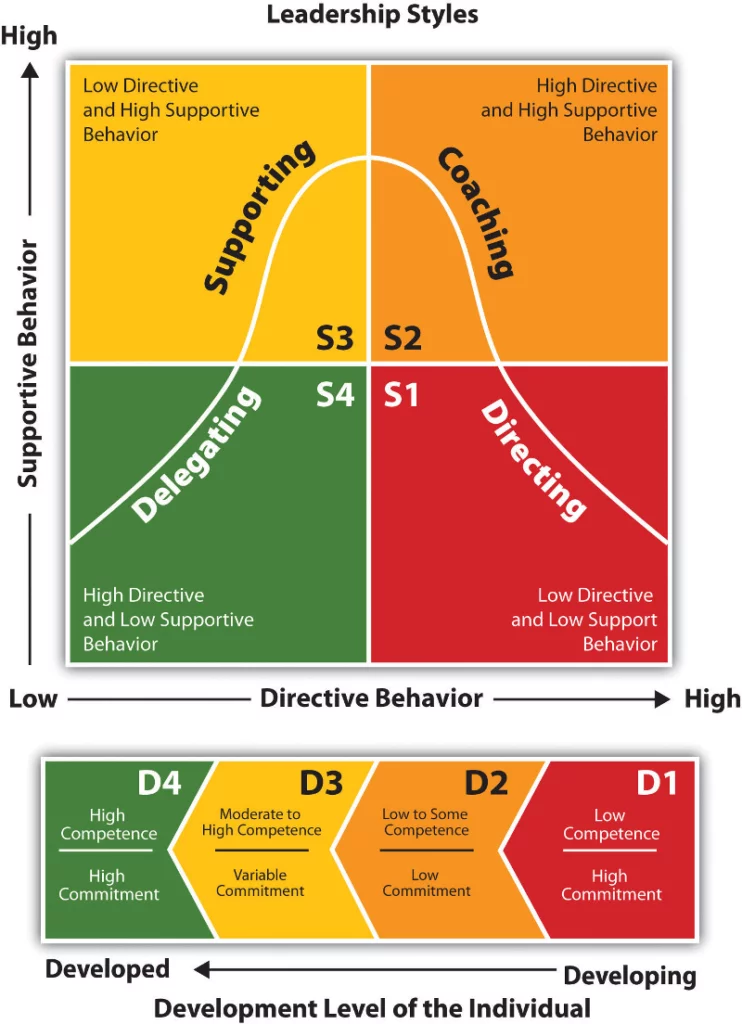You may have encountered different leadership styles in your career.
Think back to when your manager guided you through every decision when you were still new to the role. Then, when you gained enough skills and experience, they became more hands-off and allowed you to make your own decisions. A situational leadership approach like this is instrumental to your professional growth.
While no one has the "ideal" style of leadership, the best leadership approach may depend on the situation, what tasks need to be performed, and the personality of the people performing it. Thus, the best leaders must weigh different factors influencing the situation and decide which leadership style to use to match the circumstances they are in.

What is situational leadership?
Situational leadership is a type of leadership approach where leaders base how they lead on the situation at hand. It's a technique most great leaders use when circumstances require them to adjust their ways according to the people they're leading and transpiring events.
Many successful leaders know that there are a lot of things to consider when working with a team. Such as:
- skills
- personality
- experience
- motivating factors
- knowledge
Thus, this leadership style depends on your ability to modify your management approach to the team's development stage and the tasks they will perform.
Dr. Paul Hershey and Ken Blanchard developed the situational leadership theory. They believe that there's no such thing as a "one-size fits all" leadership technique, where leaders think their methods apply to every person in the team. Instead, Hershey and Blanchard's theory provides a foundation for leaders to consider each team member's development level and then adapt their leadership style accordingly.
How does situational leadership work?
Situational leadership means adjusting your management style to each situation to meet your team's needs. Your adaptability as a leader is a vital soft skill that could boost your professional career.
Since each team member has a different level of commitment and competence, the situational leadership model allows you to explore their uniqueness. As a result, you can tweak your level of support and direction to bring out the best in your employees.
For example, a manager gives new employees some slack than seasoned employees. Or leaders direct their team closely when deadlines are coming up. So, your effectiveness as a leader affects your employees' performance.
The four situational leadership styles
Hershey-Blanchard's Management of Organizational Behavior cited four leadership styles to help you and your team achieve exceptional results.
Based on this graph below, you can diagnose the situation and select the best leadership style according to the problem.

Directive behavior is the amount of direction you give your team. Therefore, the higher the direction, the less the team can make decisions by themselves. This means you tell the group what they need to do and how they should do it.
Supportive behavior is the degree of support you offer your team. Thus, the higher the support, the more the leader helps their team to perform their responsibilities well. Meaning you communicate with the team more than usual.
Directing (S1)
Telling or directing leadership style is useful when a team requires close supervision and constant guidance. Leaders who use this approach make all the executive decisions without discussing them with their team members. You may apply this method if you reassign an employee to a new department outside their expertise.
Coaching (S2)
Leaders use the selling or coaching style of leadership when a team is competent but has low motivation to perform their jobs. While the leader still makes the rules, they're more willing to consider team ideas and feedback than the directing leadership style. You may implement this style by persuading your team to get their cooperation instead of ordering them what to do.
Supporting (S3)
Supporting leadership style can be helpful when teams are competent and highly motivated in their role. Here, leaders lead by example. Although they still participate in creating ideas and decision-making, they leave it up to the team to know what to do. Adopt this approach when you have an employee who still has the drive to learn new things but is weary about the task
Delegating (S4)
Delegating leaders are responsible for their team but give little direction and guidance. This type of leader is often vision and goal-oriented, only making decisions during challenging situations. You can be a hands-off leader if you have a trustworthy team who can perform their tasks without supervision. However, even if they're skillful, they still approach you if they encounter situations that require executive decisions.
According to situational leadership theory, your behavior as a leader will depend on your team's expertise and dedication. So when your team is motivated about their task but isn't skilled enough, you offer a more directive approach. Once your team knows what to do but is still cautious, you can give supportive leadership behavior.
The key point from this example is that your effectiveness will depend on the situation you find yourself in at the moment. And it will change, so you need to adapt correspondingly.
Pros and cons of situational leadership
The situational leadership theory has its benefits and setbacks. So knowing when to use each leadership approach can help you become a great leader who faces challenges head-on.
While situational leadership is not a foolproof approach, it allows you to remain fluid and flexible as you guide your team through various situations.
Pros
- Boosts productivity. Each team member has varying skills and motivation levels. Since situational leadership requires you to evaluate each member, you empower them to become more productive. As a result of your focused leadership efforts, you also improve the quality of your team's output.
- Leadership flexibility. The biggest strength of situational leadership recognizes that every person is unique. While some leaders may use a directive approach to every member, it may affect them negatively. So using this adaptive form of leadership allows you to consider team diversity and leverage their uniqueness for overall company success.
- Focuses on team members. Because this leadership style emphasizes your adaptability as a leader, you pay more attention to your team's well-being. You recognize their strengths and improve any weaknesses. When you do these positive actions, it inspires your employees to stay with the company longer.
- Creates attentive and empathetic leaders. Attentive and empathetic leaders promote happy workers. The situational leadership style drives your attention toward your employees because you try to match their needs. So when workers feel their interests are in the leader's minds, it motivates them to produce better work.
Cons
- May cause confusion. The constant behavior shifts in your leadership approach may confuse your team members. From being hands-on to preferring the backseat when making decisions, some employees may not know how to approach a particular situation. If you're using a situational leadership style, you need to explain to your team what type of leader you are. When you clarify your management approach, your team will have more confidence in you as their leader.
- Focuses on short-term goals. Situational leaders handle things in the present moment. They tend to focus more on the team, which may result in detachment from the company's vision. To avoid this, always keep in mind your long-term goals, even if you're sorting short-term issues.
- Leader takes full responsibility. Being an adaptive leader requires a lot from you since you take full responsibility for your team's performance. This may cause a lot of stress and can lead to burnout. So, situational leadership may not work for you if you don't have strong people skills.
- Categorizing team members isn't practical. The situational leadership theory classifies your team members into four categories only. But people have complex personalities and characteristics, so grouping them based on this approach may not be practical.

Situational leadership examples
1. Steve Jobs
- 1974-1975 Engineer at Atari
- 1976 Founded Apple Computer Inc.
- 1985 Founded NeXt Computer software
- 1995 President and CEO Pixar
- 1997-2011 Apple CEO
Apple founder and CEO Steve Jobs was best known for his directive leadership style. He believed his technique was the only way to lead this team. He didn't rely on collaborative input to move the company forward. When his team would question his decisions, he would switch his approach to persuade his team to follow his orders.
Jobs wanted the best of the best when it came to his team's expertise. So he would only hire people who could contribute to his vision. Although he was the very picture of a demanding and rigid leader, his team trusted him.
2. Colin Powell
- (1958-1993) U.S. Military Service General
- (1986-1987) U.S. Deputy National Security Advisor
- (1987-1989) U.S. National Security Advisor
- (1989-1993) U.S. Chairman of the Joint Chiefs of Staff
- (2001-2005) U.S. Secretary of State
Powell's leadership approach is timeless. He worked with many great leaders throughout his career, including Richard Nixon and Mikhail Gorbachev. His extensive background experience serving his country gave way to his core leadership principle—adaptability.
Powell understood that each person is different. Some individuals are capable, while others require strengthening. Since Powell knew that many people's lives relied on his abilities, he had to adjust his leadership style within the limits of his troops' strengths and weaknesses.
3. Phil Jackson
- (1967-1980) Professional basketball player
- (1978-2011) Basketball head coach
Most Basketball fans know Jackson as the coach of some of the greatest basketball players of all time. He coached Michael Jordan, Dennis Rodman, Kobe Bryant, and Shaquille O'Neal. Because of his early N.B.A. playing career, he knows what it's like to be in his players' shoes.
He was known for his holistic coaching approach since he treated his players as unique individuals with varying personalities to put to the table. He would size up his players according to their strengths and put them in areas he knew could better the team.
For instance, he would delegate Jordan because he knew that Jordan had the skills and was a highly motivated player, while he took a directive approach with Shaq.
Phil Jackson's situational leadership skills came in handy when he switched his coaching methods with Shaq. He knew that Shaq had the potential, but his commitment was shaky. So when he became hands-on with the G.O.A.T., Shaq won M.V.P. that year.
4. John Wooden
- (1929-1932) Professional basketball player
- (1933-1975) College basketball coach
Another situational leader is John Wooden, nicknamed the "Wizard of Westwood." He was one of the best American college basketball coaches who led by example, a pinnacle of a supportive leadership style.
Wooden knew managing a college basketball team would be challenging during his coaching career. Every year his team players would change. His key players had to graduate, and new members would join the team. This meant he had to reassess his leadership strategy constantly. Although Wooden was a tough and demanding leader, he was empathetic. He always considered each player's well-being, which led to Kareem Abdul-Jabbar's success.
5. Jack Stahl
- 1979-2001 The Coca-Cola Company President & CEO
- 2002-2006 Revlon President & CEO
- 2008-2014 Dr. Pepper Snapple Group Chair of Compensation Committee
- 2016-2018 New Avon Chairman
Jack Stahl is an excellent example of a situational leader. As the former president and chief financial officer of the Coca-Cola company, he believes that good leaders are "situational." He understands that every situation calls for a different leading strategy.
Stahl learned the importance of situational leadership from his past experience working under his then-CEO, Doug Ivester. He and his team were asked to make a report on a tight schedule. Because of his inexperience and close deadlines, he failed to analyze the team's level of development. So he passed on the responsibility to the group with little guidance and support.
When the deadline came, he quickly realized this team had barely accomplished anything. Later, Stahl came to the conclusion that to be a great leader, one must know when to give support, to who, and how much.
Recommended course for you
The Situational Leadership Model
Every great leader understands that leadership is a balancing act. They know when to take charge of a project and how much to entrust tasks to their team. However, even if you're an outstanding leader but don't know how to approach unique situations differently, you may lose sight of your team's needs.
To understand what it takes to be a situational leader, this course will escort you on an educational journey of your professional career. Discover how Blanchar's adaptive leadership theory can make managing a team a walk in the park. His theory states that every situation calls for a distinct leadership style. So, while a particular case involves a diverse group of people, you'll know how to react and deal with the events accordingly.
Take this courseBecome an effective situational leader
After reading this article, can you remember if you met any situational leader? If you have, chances are they may made you feel supported and trusted. Their ability to modify their approach to different people made you feel valued.
But it doesn't mean situational leadership is the only way to lead a team because every leader is as different as their team members.
Thus, to be a situational leader, one must know how to read the situation and apply the most efficient leadership style to get the most out of it.

